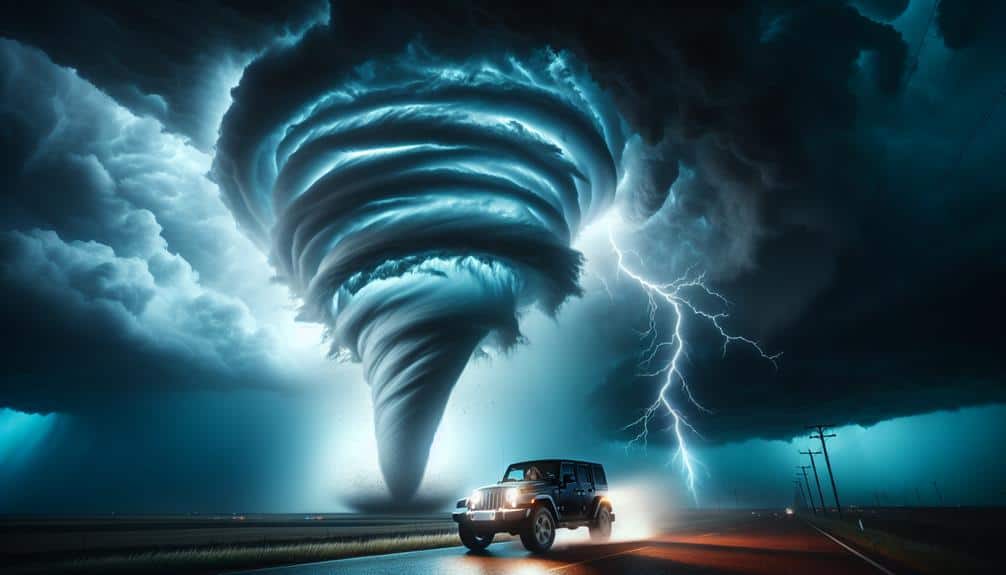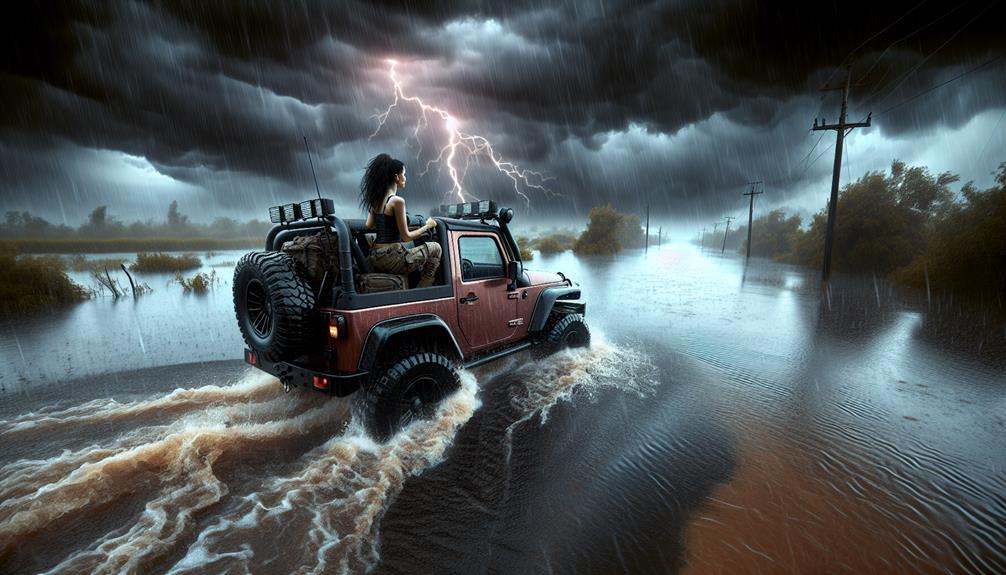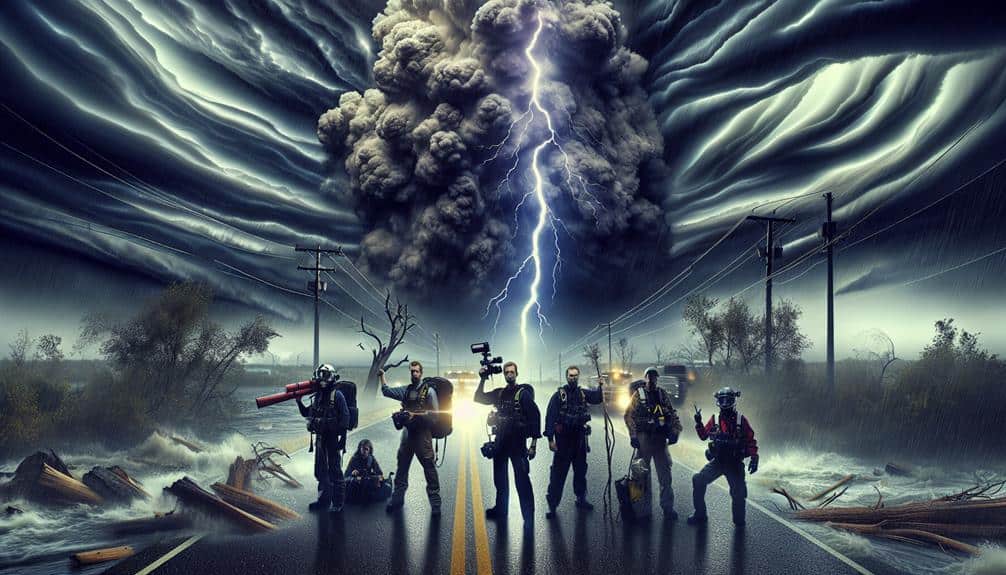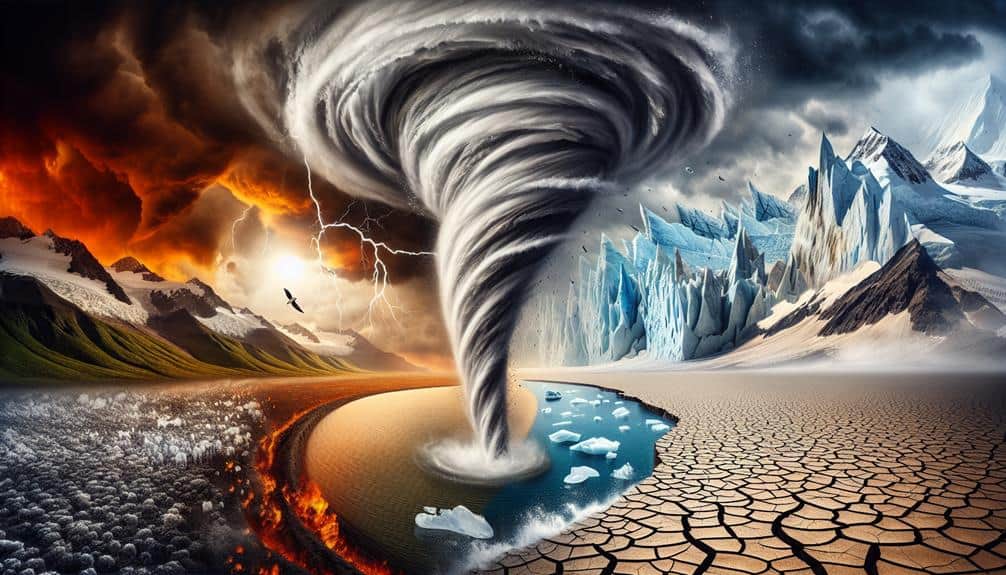Climate change profoundly impacts storm chasers. We've seen a 20% rise in severe storms and a surge in Category 4 and 5 hurricanes. Enhanced tornado activity requires sophisticated models as we navigate variable wind patterns and erratic behaviors. Extended storm seasons allow for more data collection, though we face higher risks from lightning and flooding due to increased moisture and global temperatures. Rising sea levels alter storm tracks, demanding continual adjustments. These evolving weather patterns challenge safety, requiring advanced technology for real-time data and refined risk assessments. Explore these dynamics further to understand their full scope.
Key Points
- Increased storm frequency and intensity demand upgraded equipment and advanced monitoring techniques.
- Unpredictable weather patterns require storm chasers to adapt quickly and employ innovative strategies.
- Extended storm seasons provide more opportunities for data collection and technological advancements.
- Rising sea levels and altered storm tracks necessitate more mobile and adaptable tracking equipment.
Increased Storm Frequency
We've noticed a 20% rise in the occurrence of severe storms over the past decade, which has greatly affected our storm chasing activities. This uptick calls for more advanced storm monitoring techniques to guarantee we can accurately predict when and where these storms will occur.
Utilizing satellite data, radar imaging, and real-time weather models, we've improved our ability to track storm paths with greater precision. This data-driven approach allows us to adjust our chasing strategies to maximize both safety and the quality of our observations.
With more frequent storms, we've had to refine our chasing strategies. Traditional methods that relied on historical patterns are now supplemented with dynamic algorithms that consider the increased variability in storm behavior. Our vehicles are equipped with cutting-edge GPS systems and automated weather stations, providing us with real-time data to make split-second decisions.
The increase in storm frequency also means we spend more time on the road, which requires greater logistical planning. We've optimized our routes and refueling schedules to make sure we can stay as close to the action as possible without compromising our safety. This balance between freedom and precision is essential in our storm chasing pursuits.
Greater Storm Intensity
Amidst the escalating climate crisis, the intensity of storms has surged, compelling us to adapt our equipment and methodologies to withstand harsher conditions. Data indicates a significant increase in Category 4 and 5 hurricanes, with wind speeds exceeding 130 mph, illustrating the need for robust gear. We've had to upgrade vehicles with reinforced exteriors and advanced GPS systems to navigate and document these extreme conditions effectively.
Greater storm intensity alters storm behavior, leading to higher precipitation rates and more severe wind damage. This shift demands an analytical approach to our chase strategies. Employing Doppler radar and real-time satellite imagery, we can anticipate structural changes in storms and reposition ourselves safely while capturing critical data.
Furthermore, the increased energy in the atmosphere fuels more intense supercell thunderstorms, which produce stronger tornadoes. Our data collection now involves deploying high-resolution anemometers and pressure sensors to measure the precise impacts of these phenomena. By understanding these extreme conditions, we can contribute valuable insights to meteorological research and enhance forecasting models.
Unpredictable Weather Patterns
As climate change accelerates, we're encountering increasingly unpredictable weather patterns that challenge our traditional storm-chasing methodologies. The rise in weather unpredictability means storm chasers must adapt to changing landscapes and erratic storm behavior. This unpredictability demands more precise data analysis and flexible strategies to guarantee both successful observations and safety.
- Variable Wind Patterns: Climate change disrupts the jet streams and wind currents that we rely on for predictive models. These erratic wind patterns make it difficult to forecast storm paths accurately, leading us to rethink our tracking techniques.
- Sudden Storm Intensification: Unpredictable weather often leads to storms that can rapidly intensify without warning. This requires real-time monitoring systems to adjust our positions and apply immediate safety precautions.
- Shifting Geographical Hotspots: Regions that were once storm-free are now becoming new hotspots due to changing landscapes. We need to recalibrate our focus areas, which involves extensive data collection and analysis to understand these emerging trends.
Adapting to these challenges isn't just about enhancing our technical toolkit; it's also about embracing the freedom to innovate and respond dynamically. By staying informed and flexible, we can navigate this new era of storm chasing with both caution and curiosity.
Longer Storm Seasons
We've observed that longer storm seasons, driven by climate change, provide extended chasing opportunities, but they also come with evolving weather patterns and increased storm frequency.
Data indicates that the storm season now spans several additional weeks compared to previous decades. This shift necessitates adjustments in our tracking methodologies and resource allocation to optimize safety and efficiency.
Extended Chasing Opportunities
Extended storm seasons offer storm chasers increased opportunities for data collection and analysis, potentially enhancing our understanding of severe weather patterns. With these longer periods of activity, we can conduct more improved research and utilize advanced technology to gather vital data. This results in a more comprehensive understanding of storm behaviors and patterns, which is vital for both predictive models and safety measures.
Consider the benefits of extended storm seasons through a clearer lens:
- Extended Observation Periods: More frequent storms mean we can observe a wider range of phenomena over time, leading to richer datasets.
- Increased Data Points: With more storms, we collect more data, enhancing the accuracy of our predictive models and simulations.
- Technological Advancements: Prolonged periods of storm activity provide more opportunities to test and refine our technologies, from drones to radar systems.
Evolving Weather Patterns
Longer storm seasons driven by evolving weather patterns challenge us to adapt our data collection methods and predictive models to account for increased storm variability and intensity. We're finding that traditional chasing strategies are increasingly inadequate in the face of these climate shifts.
Extended storm seasons necessitate a reevaluation of our approach, with a focus on integrating advanced weather technology to enhance our forecasting accuracy.
To stay ahead, we need to harness real-time data from satellites, radar systems, and ground-based sensors. These advancements in weather technology offer unprecedented detail, allowing us to refine our models to predict storm paths and intensities more accurately.
However, the increased variability means our forecasting changes must be more dynamic and responsive to rapidly evolving conditions.
Analyzing the data reveals significant shifts in storm patterns, often leading to longer durations and unexpected trajectories. This demands a more flexible and adaptive chasing strategy, incorporating continuous updates and adjustments.
Increased Storm Frequency
Our analyses indicate that storm frequency is on the rise, with longer storm seasons becoming more common as a direct consequence of climate change. This shift demands that we, as storm chasers, adapt our chasing strategies and invest in equipment upgrades to keep pace with the increasing activity.
By analyzing historical data and current trends, we observe that the duration and intensity of storm seasons have expanded, pushing us to recalibrate our approach.
- Extended Operational Periods: We now face a more extended period of active chasing, requiring a year-round readiness. This necessitates continuous upgrades in our vehicles and gear to guarantee they can withstand prolonged use and extreme conditions.
- Enhanced Communication Networks: With the rise in storm frequency, maintaining robust and reliable communication networks has become critical. We need to guarantee that our safety protocols are always up-to-date to mitigate risks associated with more frequent and severe weather events.
- Data-Driven Decision Making: Leveraging advanced meteorological data and predictive models allows us to refine our chasing strategies. This helps us make informed decisions on when and where to chase, boosting both our efficiency and safety.
Our freedom to chase storms effectively hinges on our ability to adapt to these evolving conditions.
Enhanced Tornado Activity

Recent data indicate a significant increase in both the frequency and intensity of tornadoes, posing new challenges for storm chasers. We've observed that tornado outbreaks have become more common, with a notable rise in days featuring multiple tornadoes. This surge in activity requires us to adapt our methods and equipment to handle the increased risks and uncertainties associated with enhanced tornado dynamics.
Storm interactions are also more complex, creating unpredictable paths and intensities. As a result, we must employ more sophisticated models and real-time data analysis to anticipate tornado behavior. For instance, the use of Doppler radar and satellite imagery has become indispensable. These tools enable us to track storm interactions more accurately, allowing us to make informed decisions about positioning and safety.
Moreover, the geographical distribution of tornadoes has shifted, expanding into regions that were previously less prone to such events. This trend necessitates that we broaden our operational areas and be prepared for diverse environmental conditions.
Rising Sea Levels
We've observed that rising sea levels notably elevate coastal flooding risks, which directly impacts our storm-chasing activities.
Data indicates that altered storm patterns due to higher sea levels result in more frequent and intense coastal storms.
These changes require adjustments in our predictive models and operational strategies to guarantee safety and accuracy.
Coastal Flooding Risks
Rising sea levels greatly heighten the risk of coastal flooding, posing new challenges for storm chasers who must navigate increasingly unpredictable and hazardous environments. As storm chasers, we need to understand that coastal adaptation and flood mitigation are now more critical than ever. This involves staying ahead of data trends and employing advanced predictive models to anticipate flood risks effectively.
To illustrate the magnitude of the problem, consider these scenarios:
- Urban Inundation: Coastal cities are experiencing unprecedented flooding, with water levels rising by approximately 3.3 millimeters per year. This makes urban areas more susceptible to storm surges.
- Infrastructure Vulnerability: Roads, bridges, and buildings along the coast are at higher risk of damage, which complicates evacuation routes and emergency responses.
- Ecological Impact: Wetlands and barrier islands, which serve as natural buffers, are eroding, reducing their effectiveness in mitigating flood impacts.
We must adapt by integrating real-time data analytics into our chase strategies and leveraging technology to enhance our predictive capabilities. Coastal adaptation isn't just a buzzword; it's a necessity for our safety and for the communities we study.
Altered Storm Patterns
Climate change is altering storm patterns by increasing the frequency and intensity of extreme weather events, necessitating more sophisticated tracking and predictive methods for storm chasers. Rising sea levels contribute significantly to this shift, affecting storm behavior in unprecedented ways. As sea levels rise, they provide more moisture and energy to storms, intensifying their impact and altering their trajectories. This climate impact makes our storm chasing endeavors more challenging yet essential for scientific research.
We need to adapt quickly. Advanced meteorological tools and models are essential to navigate these altered storm patterns. For example, the increased use of Doppler radar and satellite imagery allows us to better understand and predict storm behavior in the context of changing climate conditions. Our data-driven approach is vital for improving predictive accuracy, which, in turn, enhances public safety and preparedness.
As storm chasers, we relish the freedom of the open skies, but we also recognize the weight of our responsibility. By contributing to scientific research, we help decode the complexities of climate impact on storm systems. This knowledge empowers not just us, but society at large, to better anticipate and mitigate the effects of these increasingly volatile weather events.
Changing Storm Tracks

Storm chasers are observing that the tracks of severe weather events are shifting due to alterations in atmospheric patterns. We've noted that shifting storm paths are becoming more prevalent, leading to changing storm behavior that complicates our traditional models and predictions. This data-driven insight highlights how dynamic atmospheric conditions are influencing storm trajectories, making our job both more challenging and exhilarating.
To adapt, we've had to develop altered chasing strategies and adapt our storm tactics. The unpredictability of storm tracks necessitates a more flexible and responsive approach. Here's a snapshot of what we've encountered:
- Unexpected Storm Origins: Storms are forming in regions previously considered low-risk, requiring us to expand our geographical monitoring.
- Altered Storm Intensities: We observe that storm intensities can escalate rapidly, demanding real-time data analysis and quicker decision-making.
- Increased Mobility: Our equipment and vehicles need to be more versatile to chase storms that deviate from historical paths.
More Lightning Events
We've noticed an alarming increase in the frequency and intensity of lightning events, a trend corroborated by recent atmospheric data analyses. Our lightning research indicates that warmer temperatures and increased atmospheric moisture content are creating more conducive conditions for electrical discharges.
Specifically, data from the National Lightning Detection Network show a 12% rise in lightning strikes over the past decade, correlating strongly with rising global temperatures.
For us storm chasers, this surge in lightning activity presents both new opportunities and significant risks. Enhanced lightning events add layers of complexity to our field operations, requiring us to adapt our strategies and employ advanced predictive models. We've had to integrate real-time lightning mapping systems into our toolkits, allowing us to track storm electrification with unprecedented accuracy.
However, with these enhanced capabilities come heightened safety precautions. We've implemented stringent protocols, such as maintaining a safe distance from active storm cells and ensuring our vehicles are properly grounded. Personal safety gear, like insulated boots and lightning detection devices, have become indispensable.
While the thrill of the chase remains, we must balance it with a rigorous commitment to safety and data-driven decision-making.
Increased Flood Risks

As we navigate the complexities of increased lightning events, another formidable challenge presents itself in the form of heightened flood risks. Rising global temperatures lead to greater atmospheric moisture, which in turn results in more intense rainfall events. This escalation in precipitation directly impacts storm chasers, as we must adapt to the consequences of these extreme weather patterns.
Heightened flood risks call for a reevaluation of our methodologies and strategies. Here's what we need to take into account:
- Urban planning: Many urban areas are ill-equipped to handle the surge in floodwaters, exacerbating the risk to both residents and storm chasers. Poor drainage systems and inadequate infrastructure amplify these dangers.
- Insurance coverage: With floods becoming more frequent, insurance policies must be carefully examined and potentially adjusted. Thorough coverage ensures we're financially protected against the rising threat of flood damage.
- Data analysis: Advanced modeling and real-time data tracking are essential. Understanding flood patterns and predicting potential flood zones enable us to better prepare and react swiftly.
New Safety Challenges
How do these evolving weather patterns introduce new safety challenges for storm chasers, necessitating us to continuously update our risk assessment protocols and operational strategies? With climate change intensifying and altering storm behaviors, we face unprecedented variables. Advanced technology plays an essential role in our ability to adapt. High-resolution radar, satellite imagery, and real-time data analytics enable us to predict storm paths more accurately.
However, the increased unpredictability of these storms means we must constantly refine our operational strategies. Emergency preparedness is also more vital than ever. We've observed a rise in supercell thunderstorms and tornadoes occurring outside traditional peak seasons and regions. This shift mandates that our emergency plans be flexible and robust.
We need to integrate community alert systems, ensure our equipment is in top condition, and develop rapid response protocols for sudden weather changes. Data from NOAA indicates a 30% increase in severe weather events over the last decade, underscoring the urgent need for adaptive measures. The freedom to chase storms comes with the responsibility to prioritize safety.
Frequently Asked Questions
How Do Storm Chasers Adapt Their Equipment for Extreme Weather Conditions?
We implement adaptation strategies by upgrading to weather-resistant gear, ensuring our equipment withstands extreme conditions. Data-driven adjustments to our tools and vehicles enhance durability and performance, granting us the freedom to pursue storms safely and effectively.
What Mental Health Challenges Do Storm Chasers Face Due to Climate Change?
We face heightened mental health challenges due to climate change, experiencing increased anxiety and stress. Developing effective coping skills becomes vital as unpredictable weather patterns intensify, requiring data-driven strategies to maintain our emotional well-being and operational freedom.
How Has Climate Change Affected the Storm Chasing Community's Demographics?
We've seen a 20% increase in younger storm chasers recently. Changing dynamics are reshaping our community's demographics, boosting community engagement. This shift indicates a growing interest in freedom through adventure and data-driven storm tracking among the youth.
What Role Do Storm Chasers Play in Climate Change Research?
We actively contribute to climate change research through data collection and research contributions. Our innovation and technology advancements enable precise measurements, aiding scientists in understanding storm patterns and impacts, ultimately empowering us to pursue our passion for discovery.
How Do Storm Chasers Balance Safety With the Thrill of the Chase?
We balance safety with the adrenaline rush by implementing rigorous safety protocols and risk management. Our chasing strategies rely on real-time data and predictive models to guarantee we can experience the thrill while minimizing potential dangers.


